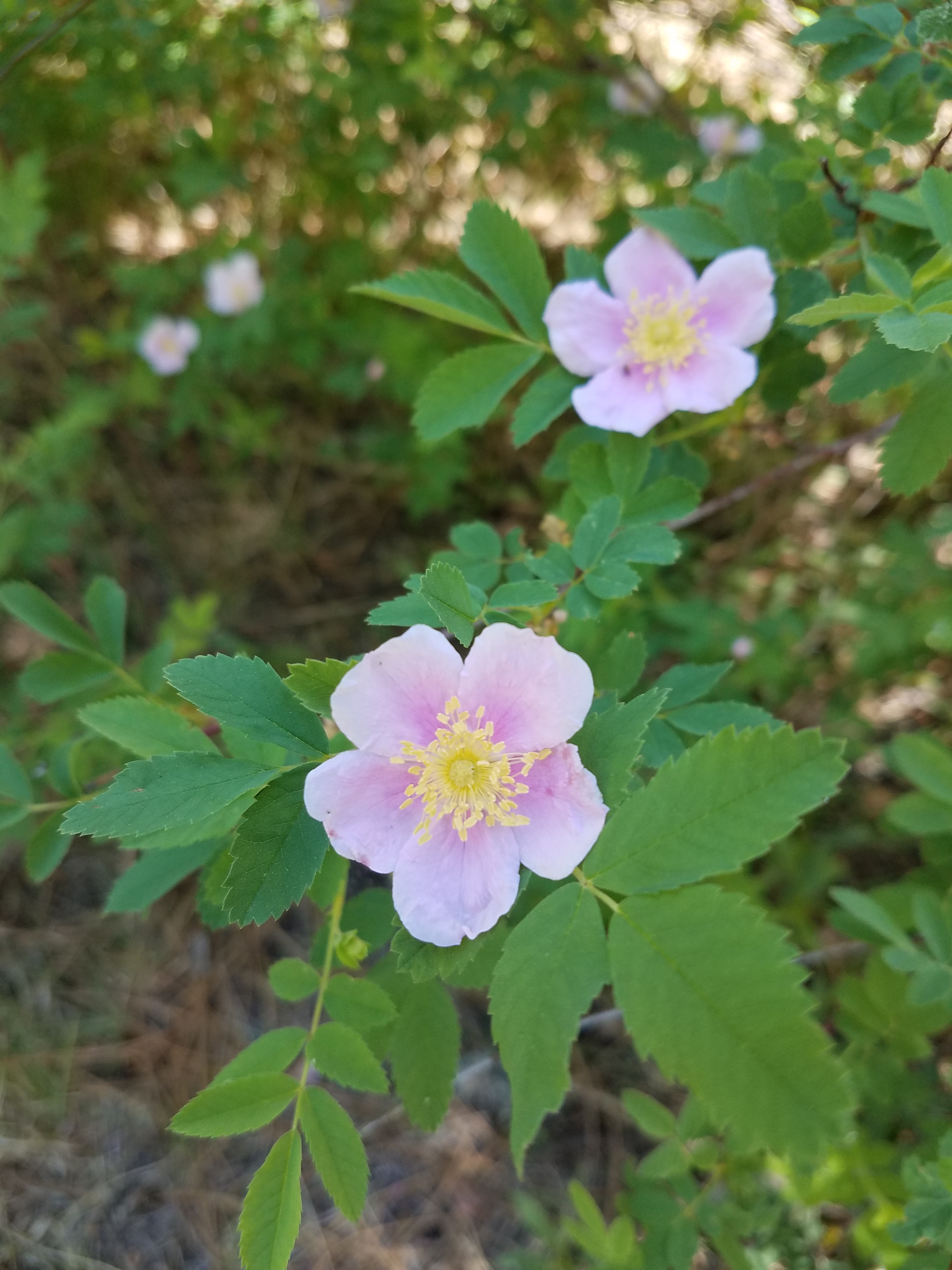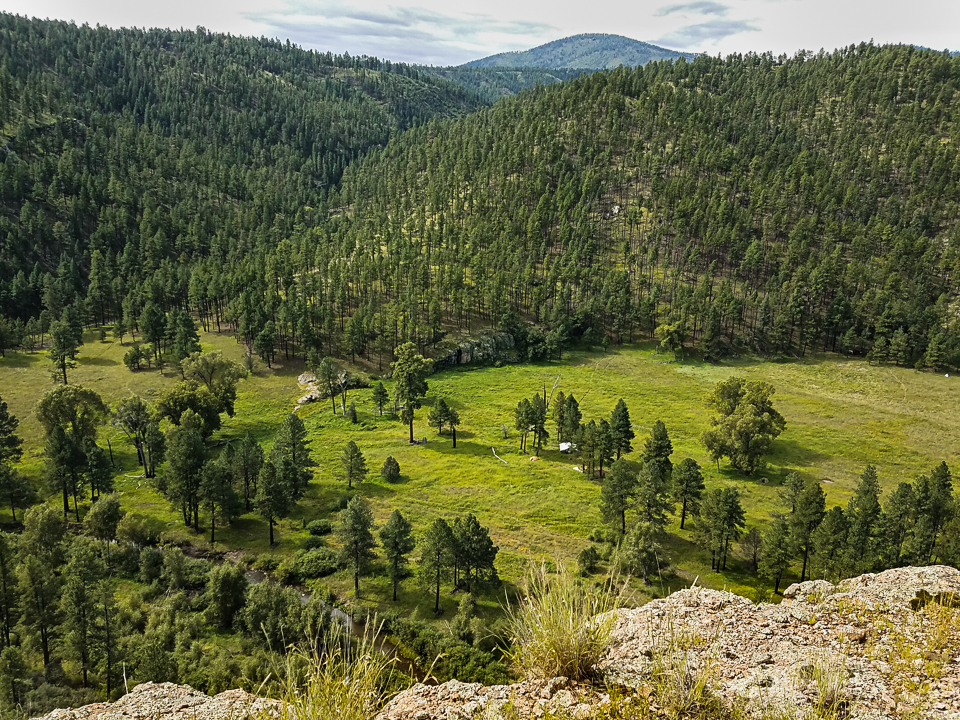30 miles in 3 days – Day 3


Dawn came softly. I had just closed my eyes to a deep sky full of stars, and now I opened to a sky just lightening. Carol’s and Allyson’s sleeping bags were not moving, suggesting that they were both still in the Land of Nod. Behind me, though, I could hear firewood being thrown onto the morning fire. Looking past my feet into the trees, six horses moved at a hobbled pace through the grass, heads down and cropping. They had been released from their ties and sent out to breakfast.
I resisted the urge to immediately go looking for coffee, instead rolling up my sleeping bag, folding my tarps, gathering my stuff into a coherent pile and taking my saddle pads over to where the saddles and tack were stacked. My saddle blanket went with me to fireside to provide my seat cushion on the log.

Other than a bright good-morning, Corbin and Joe continued getting ready for our day: building up the fire, filling the coffee pot and the cook pot with water and setting them on the coals to boil, cutting fruit for our breakfast of oatmeal. Corbin had made a comment the evening before that there’s something therapeutic about sitting and staring into a campfire. I practiced a little pre-prandial therapy, since there was little I could do to help the preparations. Eventually, we were all gathered, coffee mugs and oatmeal in hand and the day properly begun.
As we sat and compared nighttime noise stories – I had heard a Great Horned Owl and wondered if anyone else did – occasionally either Joe or Corbin would count to six. If they only counted to five, Corbin would go in search of the missing horse. This was something I had observed previously while in camp. Even though hobbled around the front feet, a horse can make quite a bit of headway, often ranging out of sight. He would encourage them back, usually with little trouble. His horse, Biscuit, had an investigative nose. She was often poking around the food stores, poking at Corbin’s bedroll, or at anything else she found interesting. Poor Smoke, on the other hand, had little patience for her hobbles. This morning, as she tried to move forward, she stumbled over her front feet, sat back on her haunches, and stood in a quiver. Joe looked at her and just shook his head. When I curried and cajoled her later, I noticed that she had a little scrape on each front foot, just above the hoof.
Well fed, once again, and it was time to pack up for our last day. As we were ready to leave the fire, Corbin – or was it Joe? – told us that not long after we left the camp, we would come to a part of the trail that runs along on the side of a steep hill for about 1/4 mile. Looking right at me, he said, “But Smoke is an old pro at this.” Well, yes, maybe she is. But I surely am not.
Oy vey. And here I thought the rest of our ride would be a stroll along the river, with the terror of yesterday’s Hells Hole put behind us. Well, as an old country song goes, “If you got your confidence with you, you can do anything.” We saddled up, mounted up, and headed out on our last 10+/-miles, including that 1/4 mile of hillside. I started working on my confidence right away.
Sure enough, it wasn’t long before the trail trended upward along the side of a partially wooded-partially rocky slope. It wasn’t steep enough to switchback and we weren’t climbing to the top. Rather the trail continued laterally. However, the challenge became obvious quickly. Most of the hillside was composed of talus slumped down from the top. Here was a difficulty for the horses that they didn’t have to navigate coming down Hells Hole trail. The trail was etched in across loose rock that clinked and slipped under their feet as they minced their way along. And then there was about 8 feet of slickrock slanted downhill to cross.
I engaged in both an out-loud and an under-breath conversation getting across that quarter-mile. “Watch your feet, girl. Ok, Smoke, be careful. You can do this.” Alternating with, under my breath: “f**kohf**kohsh*tTrust Your Horseahsh*tTrust Your Horseahf**k.” “Good Smoke, watch your feet, girl. Take it easy, Smoke.” Well, she did and Joe, who’d been leading on Jet, with Kissee tethered to him, was waiting on the now-wooded and pine-needled gentling slope to give me a thumbs-up. I grinned and announced the obvious, “I made it, white knuckles and all.” Allyson, riding behind me, had heard my overt exhortations to Smoke, but fortunately not my self-talk.

The West Fork Gorge is stunning. The walls are crenelated and hoodoo-ed. The river slips between the walls, sometimes pushing the trail up against the foot of the cliffs, sometimes forcing the trail up and over little ridges. A lot of rock on the river edges and in the river bed, rock of not insignificant size. Some of the riversides are a drop from a level trail, down a rocky slope and up on the far side. Smoke picked her way carefully down the rock, stepping between rocks in crossing the river and jostling up the far slope. Occasionally, her foot would step into a hole, pitching us forward. I did a lot of standing in my stirrups – stand-and-lean-back going down and stand-and-lean-forward to get up the other side. I peeked at the walls and spires of the gorge as much as I could. We stopped at several river crossings to water the horses and took advantage of those moments to pull out cameras and make record of the beauty and drama. This was part of the magic I didn’t want to miss.




Eventually we encountered people. And dogs. And noise. Backpackers setting up camp under a rock overhang. Hikers with two loose dogs; they held the dogs as we walked by. More hikers, casual as they stepped off-trail. Just as we were plunged into the vibrant fall colors and through the flood plain covered with Chamisa as we left the Gila Cliff area, we rode back into that environment after crossing the boundary out of the Wilderness.



Coming into Woodys Corral, we were met by Joe’s support team with their trucks and trailers. I got my last dismount assist, took Smoke to a rail and tied her up. I unloaded my personal gear and put it in Carol’s car. Then, I unbridled Smoke and with Corbin’s help, pulled off the saddle, the saddle pads and blanket, saddle bags, rope and all the accoutrements of the trail and took everything to Joe’s truck. Time to say goodbye to Smoke. I rubbed her muzzle and scratched her forehead and down between her eyes. I reached under her chin and gave her head a hug. Another muzzle rub and another attempt at a head-hug. I guess Smoke isn’t a hugger; she tossed her head up and away from my attention. So, ok, I get it. Well, bye, Smoke. And thanks.




















 One half of the canyon follows Gallinas creek (Guy-ē-nas). The creek was running full, though not as full as it would have been earlier in the Spring with snow melt and will be again with monsoons. The trail crossed the creek any number of times but given the lower level of the water, the stepping stones were raised and dry.
One half of the canyon follows Gallinas creek (Guy-ē-nas). The creek was running full, though not as full as it would have been earlier in the Spring with snow melt and will be again with monsoons. The trail crossed the creek any number of times but given the lower level of the water, the stepping stones were raised and dry.

 Here, we found wild rose, delicately scenting the air. On the sunnier side of the trail, there was cactus blooming and other wildflowers providing color. Banana yucca held up cream-colored stalks on far rock slopes.
Here, we found wild rose, delicately scenting the air. On the sunnier side of the trail, there was cactus blooming and other wildflowers providing color. Banana yucca held up cream-colored stalks on far rock slopes.






 Wilderness isn’t empty, not of people and not of things. To the right of the trail, silhouetted against the sky is a relic: a 40’s era truck driven out to the edge of the world and abandoned, fodder for curious hikers’ wonder and speculation.
Wilderness isn’t empty, not of people and not of things. To the right of the trail, silhouetted against the sky is a relic: a 40’s era truck driven out to the edge of the world and abandoned, fodder for curious hikers’ wonder and speculation. There’s an overlook where we see our destination, a river-side meadow specked with the white kitchen tent secluded under a clutch of pines. The scary aspect of the view is that we have to get down there. As we pick our way among the trail rubble, we hear the mules coming with our weight of tents and bags. The outfitter calls down to us, “Move to the downhill side. Mules spook if a critter is above them. Is that you behind a bush? Move out where the mules can see you.” I step down and out of the way, and watch the outfit step on by us, more surefooted than I am, for sure. Then, we work our way on down to level ground, off the sun-exposed cliff-side and into the shade.
There’s an overlook where we see our destination, a river-side meadow specked with the white kitchen tent secluded under a clutch of pines. The scary aspect of the view is that we have to get down there. As we pick our way among the trail rubble, we hear the mules coming with our weight of tents and bags. The outfitter calls down to us, “Move to the downhill side. Mules spook if a critter is above them. Is that you behind a bush? Move out where the mules can see you.” I step down and out of the way, and watch the outfit step on by us, more surefooted than I am, for sure. Then, we work our way on down to level ground, off the sun-exposed cliff-side and into the shade.








